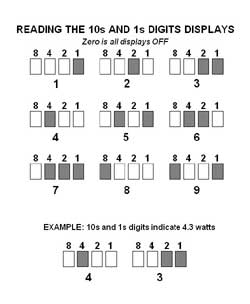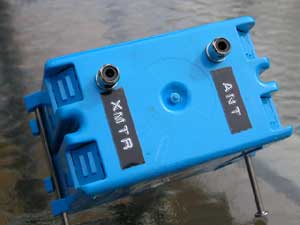This article appeared in the May 2005 edition of WorldRadio magazine. It is
reprinted here with permission.
MAY
THE QRP FORCE BE WITH YOU
By Richard Fisher, KI6SN
QRP columnist, WorldRadio magazine
This project didn't start out as a candidate
for the "Star Wars R2-D2 Look-alike Contest" - but it certainly turned
out that way.
"May the QRP Force be with you."
What we have here is the KD1JV Power and
SWR Meter kit - one of the neatest QRP station accessories you'll ever see.
It's the kind of thing we've come to expect from contemporary QRP's most innovative
and prolific circuit designer - Steve Weber.
He's teamed with the Four State QRP Group,
an organization of low power enthusiasts with footprints in Arkansas, Oklahoma,
Kansas and Missouri, to make the kit widely available. And the price won't break
your bank.
It's a "compact RF power and SWR measuring
device for use in the shack and in the field." Two-digit BCD encoded display
- via two banks of four light-emitting diodes (LEDs) each - is employed to indicate
SWR of 50-ohm coaxial-fed transmission lines and power in two ranges. There's
a 9.9-watt scale and a 990 milliwatt scale.
VSWR readings can be read from 1:1 up to
9.9:1.
The circuit offers accuracy within 5 percent
of its reading from 1.8 MHz to 50 Mhz - 160 meters to 6 meters.
Minimum sensitivity for RF detection is
20 milliwatts, there's both manual and automatic power shutdown to the device
and it's powered by as little as two 1.5-volt AAA batteries.
And for SSB operators, there's even a provision
for peak-hold mode in the 9.9 watt measurement scale.
That's an awful lot of features packed
into a high-quality plated-through printed circuit board that can snugly fit
into an Altoids tin.
And for $26 post-paid to U.S. locations
and $29 to Canada and DX, it's one of the best bargains around.
If you're new to the concept of BCD encoded
display, it's a pretty simple and easy-to-learn concept. Instead of using a
microammeter, like so many QRP power / SWR meters have historically, the 4SQRP
kit displays readings using a total of eight bright red LEDs. Which LEDs are
illuminated in each bank of four gives the operator the power and SWR readouts.
The accompanying graphic shows how it's done.
 The
LEDs are grouped into two banks. One bank indicates the 10s digit. The other
shows the 1s digit. Numbers are assigned to each of the four LEDs in each bank.
Going left to right, the first LED represents 8. The second represents 4. The
third is 2 and the fourth is 1.
The
LEDs are grouped into two banks. One bank indicates the 10s digit. The other
shows the 1s digit. Numbers are assigned to each of the four LEDs in each bank.
Going left to right, the first LED represents 8. The second represents 4. The
third is 2 and the fourth is 1.
So, when we're measuring power and the
second LED from the left in the 10s bank is lit, that indicates 4 watts. Similarly,
if the third and fourth LEDs in the 1s bank are lit, that indicates .3 watts
(2 + 1 equals 3). Combine the two readings and you've got 4.3 watts.
As a journalist - not a mathematician -
I feared I'd be really challenged by having to interpret these indicators and
"do the math" for each reading. It is amazing, though, how intuitive
it all becomes in just a few minutes of playing with this nifty little unit.
For instance, the last two LEDs in the
10s bank are glowing at the same time the middle two LEDs of the 1s bank are.
That's 3.6 watts. Bingo!
Reading VSWR is done the same way. Apply
power, and let the red lights do the talking.
Two additional LEDs positioned just above
the 10s and 1s bank indicate what mode the circuit is in: 9.9 watt scale, 990
milliwatt scale, peak reading 9.9 watt scale or VSWR indication. The operator
toggles through the choices using a pushbutton switch mounted on the PC board.
The coolness of this project does not end
with the PC board, the parts and the performance of the kit, however. The manual
comes on a CD. Pop it into your computer and you've got 12 pages of step-by-step
building and operating instructions ready to be viewed or printed out. There's
also a section on theory of operation and complete schematics.
As you'll see, "a classic Stockton
directional coupler is used as a sensing element." The Amtel AVR series
AT Tiny26L micro-controller is the heart of the circuit, containing a 10-bit,
10 input channel A / D converter, 2K of FLASH program memory, 128 bytes of unused
EEPROM memory, 128 bytes of static RAM, built-in R / C clock, timers and more
than 100 instructions - "most with true one clock cycle execution."
Whew!
According to the manual, "power is
calculated by squaring the peak forward voltage and then dividing by 100. This
formula isn't as precise as rms voltage squared, then divided by 50, but is
close enough given the overall accuracy of the meter." The calculation
is done in binary to 32-bit precision. "The results are then converted
into packed BCD and outputted to the display LEDs."
The circuit's two chips are installed in
sockets and there is one binocular-style toroidal inductor to wind. But it's
not beyond the capabilities of the builder with even limited experience.
The kit arrived at KI6SN nicely packaged
along with the CD-manual. Parts are listed in the instructions in the order
in which you install them. It took me a little more than an hour to mount the
parts, calibrate the unit and put it in line for a smoke test.
It worked beautifully the first time power was applied. And the accuracy matched
readings from two other wattmeter / SWR units I had on hand.
 I
liked the board and circuit so much I opted to mount it outboard on a plastic
electrical box from Home Depot - allowing a clear view of the LEDs. Thoughts
of R2-D2 emerged after sitting the unit atop the NorCal 40 transceiver here.
With its LEDs flashing, the KD1JV Power and SWR Meter has become quite the conversation
piece.
I
liked the board and circuit so much I opted to mount it outboard on a plastic
electrical box from Home Depot - allowing a clear view of the LEDs. Thoughts
of R2-D2 emerged after sitting the unit atop the NorCal 40 transceiver here.
With its LEDs flashing, the KD1JV Power and SWR Meter has become quite the conversation
piece.
For ease of operation, I added an ON /
OFF switch, a top-panel mounted pushbutton MODE switch and a more robust battery
pack: 3 AA cells.
Does it sound like this kit is going to
get a heck of a lot of use at KI6SN? You better believe it.
 For
more information on the kit and details for ordering, visit the Four State QRP
Group's web site at: http://4sqrp.com/kits/kits.htm
For
more information on the kit and details for ordering, visit the Four State QRP
Group's web site at: http://4sqrp.com/kits/kits.htm
To purchase a kit, send a check or money
order to: Bart Lawson, W0IIT, 711 East 31st St., Pittsburg, KS 66762. A label
with the address where you'd like the kit shipped would be appreciated.
Make out the check or money order to: 4SQRP
Group
Back
to 4SQRP Home Page
 The
LEDs are grouped into two banks. One bank indicates the 10s digit. The other
shows the 1s digit. Numbers are assigned to each of the four LEDs in each bank.
Going left to right, the first LED represents 8. The second represents 4. The
third is 2 and the fourth is 1.
The
LEDs are grouped into two banks. One bank indicates the 10s digit. The other
shows the 1s digit. Numbers are assigned to each of the four LEDs in each bank.
Going left to right, the first LED represents 8. The second represents 4. The
third is 2 and the fourth is 1.
